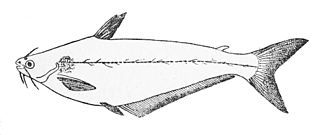
Dianchi Lake, also known as Lake Dian and Kunming Lake, is a large lake located on the Yunnan-Guizhou Plateau close to Kunming, Yunnan, China. Its nickname is the "Sparkling Pearl Embedded in a Highland" and it was the model for the Kunming Lake in the Summer Palace in Beijing. Its name is the source of Yunnan's Chinese abbreviation 滇.
Sinocyclocheilus is a genus of freshwater fish in the family Cyprinidae endemic to China, only found in Guangxi, Guizhou and Yunnan. Almost all of its species live in or around caves and most of these have adaptions typical of cavefish such as a lack of scales, lack of pigmentation and reduced eyes. Several species have an unusual hunchbacked appearance and some of the cave-dwellers have a "horn" on the back, the function of which is unclear. In contrast, the Sinocyclocheilus species that live aboveground, as well as a few found underground, show no clear cavefish adaptions. They are relatively small fish reaching up to 23 cm (9.1 in) in length. The individual species have small ranges and populations, leading to the status of most of the evaluated species as threatened. Many species populations in the genus have yet to be evaluated by the IUCN.
The elongate bitterling is a species of freshwater fish in the family Cyprinidae. It is found only in shallow water areas along the shores of Lake Dianchi in China.
Cyprinus micristius, the Dianchi carp, is a critically endangered species of ray-finned fish in the family Cyprinidae. It is found only in Lake Dianchi and its tributaries in Yunnan, China. The nominate subspecies from the lake itself has not been confirmed since the 1960s.
The duck-billed golden-line fish is a species of cyprinid. It is found only in China.
The gold-colored angel fish is a species of cyprinid fish.
The eyeless golden-line fish or blind golden-line barbel is a species of ray-finned fish in the family Cyprinidae. It is a cave-dwelling, blind species only known from the Yiliang County, Yunnan, China. Its maximum length is 113 mm (4.4 in) SL.
The hyaline fish is a species of ray-finned fish in the family Cyprinidae. This threatened species is found only in Yunnan in China. Like many other cavefish, it lacks scales, pigmentation and external eyes. The first recorded description of an obligate cavefish involved this species, when mentioned in 1540 in the travel notes of Yingjing Xie, a local governor of Guangxi.
The small eye golden-line fish is a species of ray-finned fish in the family Cyprinidae. It is found only in China.

The African butter catfish is a species of fish in the family Schilbeidae. It is native to many major river systems in Africa. Other common names for the fish include butter fish, butter barbel, African glass catfish, lubangu, mystus catfish, silver barbel, and silver catfish. It was originally described as Silurus mystus by Carl Linnaeus in 1758.
The Kunming catfish is a critically endangered species of catfish in the family Siluridae. It is endemic to Dian Chi Lake, China. There have been no confirmed records in decades and it is feared extinct. S. mento grows to a length of 21.5 centimetres (8.5 in) TL.

Fuxian Lake stretches out through Chengjiang, Jiangchuan and Huaning Counties in Yunnan Province, spanning an area of 212 square kilometers. The lake is ranked third-largest in Yunnan, after Dian Lake and Erhai Lake. Also the deepest lake in Yunnan, it is 155 meters deep at its greatest depth. It is also the third-deepest fresh water lake in China, after Tianchi and Kanas Lake.
The Kanglang fish is a species of cyprinid fish. It is a pelagic species endemic to Fuxian Lake in Yunnan, southern China. However, the species may now be in the process of extinction because of the introduced noodlefish Neosalanx taihuensis, with which it is competing for food.
Sinocyclocheilus altishoulderus is a species of cave fish in the family Cyprinidae. It is endemic to Guangxi province in southern China, and only known from a cave in Donglan County, from a subterranean tributary of the Hongshui River, a tributary of the Pearl River.
Sinocyclocheilus donglanensis is a species of cave fish in the family Cyprinidae. It is endemic to Guangxi province in southern China, and only known from a subterranean tributary of the Hongshui River, a tributary of the Pearl River. Its specific name donglanensis refers to the Donglan County where its type locality is located. It is not known from elsewhere.
Sinocyclocheilus tingi is a species of freshwater fish in the family Cyprinidae. It is only known from Fuxian Lake in Yunnan. It grows to 18.3 cm (7.2 in) SL.
Sinocyclocheilus yangzongensis is a species of ray-finned fish in the genus Sinocyclocheilus.
Schizothorax grahami is a species of ray-finned fish in the genus Schizothorax. It is endemic to Lake Dianchi, its tributaries and connected springs, in Yunnan Province, China. The species has not been caught in the lake in the past 20 years, but it is present in one tributary drainage basin. The introduction of exotic fish is the main threat to this species.
Triplophysa grahami is a small species of stone loach from China. It is endemic to the Jinsha River basin in Yunnan, Southwest China. There is also a record from Lishe River, but this is believed to be a different species. It grows to 9.1 cm (3.6 in) standard length. It lives in the spaces between stones and floating grasses in slow streams.
Liobagrus kingi, the King's bullhead, is a species of catfish in the family Amblycipitidae endemic to China, where it is known to occur in the lake Dianchi basin, in its tributaries and effluent river, the Zhangjiu, and two tributaries of the Jinshajiang river in Sichuan and Yunnan. It has not been recorded in the lake since the 1960s. This species grows to a length of 9.5 centimetres (3.7 in) SL.



